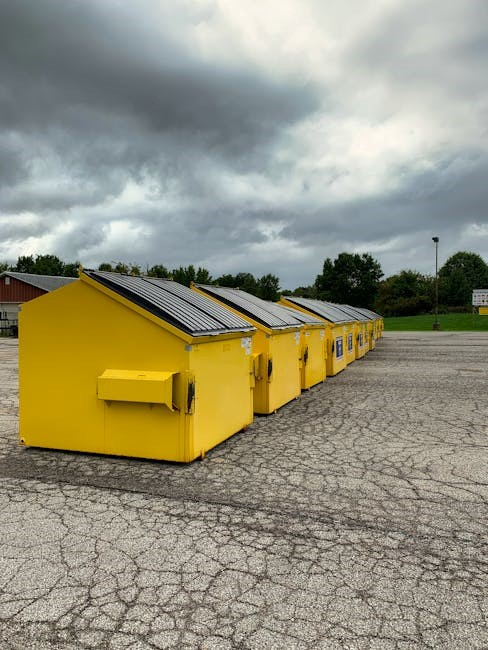This section introduces the concept of valet trash service, highlighting its role in modern waste management and its growing popularity in multi-family communities for efficiency and resident satisfaction.
1.1 Definition of Valet Trash Service
Valet trash service involves doorstep waste collection, offering convenience and efficiency for residents. It differs from traditional systems by providing direct pickup, often with flexible scheduling and real-time monitoring, enhancing overall waste management efficiency and resident satisfaction in multi-family communities.
1.2 Importance of Valet Trash Service in Modern Waste Management
Valet trash service enhances waste management by streamlining collection processes, reducing litter, and increasing recycling rates; It addresses urban challenges like limited bin space and high disposal costs, offering a sustainable solution that improves community cleanliness and environmental standards, making it vital for modern urban living.
Key Components of a Valet Trash Service Proposal
This section outlines the essential elements of a valet trash service proposal, including executive summaries, service features, pricing, and contract terms, ensuring clarity and transparency for clients.
2.1 Executive Summary
An executive summary provides a concise overview of the valet trash service proposal, detailing the services offered, benefits, and value proposition. It highlights key components such as cost-effectiveness, operational efficiency, and enhanced resident satisfaction, serving as a snapshot for decision-makers to evaluate the proposal’s alignment with their needs and goals. The summary ensures clarity and brevity, making it easy to understand the proposal’s core strengths and objectives.
2.2 Service Features and Benefits
Valet trash services offer convenient door-to-door waste collection, reducing the need for residents to handle heavy bins. Features include scheduled pickups, eco-friendly practices, and real-time monitoring with smart bins. Benefits for property managers include improved resident satisfaction, enhanced property aesthetics, and compliance with waste management regulations, creating a cleaner and more sustainable living environment.
2.3 Pricing and Contract Terms
Pricing for valet trash services is typically based on property size, service frequency, and the number of units. Contracts usually outline terms like service duration, payment schedules, and termination clauses. Additional fees may apply for special requests or equipment rentals. Transparent pricing structures ensure clarity, while flexible contract terms accommodate unique property needs and budget constraints effectively.
Benefits of Valet Trash Service for Property Managers
Valet trash services enhance property value, improve resident satisfaction, and streamline waste management. They save time, reduce costs, and ensure a cleaner, more convenient living environment for residents.
3.1 Convenience and Time-Saving
Valet trash services eliminate scheduling hassles by offering door-to-door collection, saving property managers and residents significant time; This streamlined process reduces the need for manual sorting or trips to dumpsters, enhancing overall efficiency and convenience while minimizing disruptions to daily operations.
3.2 Cost Efficiency and Budget-Friendly Solutions
Valet trash services often provide tailored pricing models, reducing operational costs for property managers. By optimizing waste collection routes and frequencies, these services minimize expenses without compromising service quality, offering a cost-effective solution that aligns with property budgets and financial goals.

3.3 Enhanced Property Value and Resident Satisfaction
Valet trash services contribute to a cleaner, more organized community, enhancing property appeal. Residents appreciate the convenience, leading to higher satisfaction and retention rates. This service often becomes a key amenity, distinguishing properties in competitive markets and boosting overall property value through improved aesthetics and resident experience.

Regulatory Compliance and Environmental Considerations
This section covers licensing requirements, environmental standards, and sustainability practices for valet trash services, ensuring eco-friendly waste management and adherence to local regulations and community expectations.
4.1 Licensing Requirements for Waste Disposal Services
This section outlines the necessary permits and compliance measures for valet trash services, ensuring adherence to local, state, and federal regulations. Proper licensing is essential for legal operation, and specific requirements may vary by jurisdiction, including permits for waste transportation and disposal. Compliance ensures environmental responsibility and avoids legal penalties, maintaining trust with clients and regulatory bodies.
4.2 Environmental Standards and Sustainability Practices
Valet trash services must align with environmental standards, promoting sustainability through efficient waste collection and recycling programs. Implementing smart trash bins and real-time monitoring systems enhances operational efficiency while reducing environmental impact. Proper waste segregation and adherence to eco-friendly practices ensure responsible disposal, contributing to a greener future and meeting community expectations for sustainable waste management solutions.

Customer Testimonials and Case Studies
Customer testimonials highlight satisfaction with valet trash services, emphasizing convenience, efficiency, and improved property aesthetics. Case studies demonstrate measurable benefits, such as reduced waste management issues and enhanced resident satisfaction.

5.1 Success Stories from Satisfied Clients
Residents praise valet trash services for their convenience and efficiency. Properties report reduced waste management issues and improved aesthetics. Testimonials highlight how the service enhances overall living experiences and satisfaction, with many clients noting significant cost savings and positive feedback from tenants.
5.2 Real-World Applications and Results
Valet trash services have been successfully implemented in large communities, apartment complexes, and urban areas. Real-time monitoring systems, like smart trash bins, optimize waste collection routes, reducing costs and environmental impact. Case studies show improved efficiency, with a 30% reduction in waste collection time and a 25% decrease in missed pickup incidents, enhancing overall service reliability and sustainability.

Proposal Structure and Format
A well-organized proposal includes a cover page, table of contents, detailed service descriptions, and terms and conditions, ensuring clarity and professionalism in presenting the valet trash service offering.
6.1 Cover Page and Table of Contents
The cover page should include the company name, logo, proposal title, and date. The table of contents provides a clear outline of the proposal’s sections, such as executive summary, service features, pricing, and implementation plans, ensuring easy navigation for the reader.
6.2 Detailed Service Description
This section outlines the specifics of the valet trash services offered, including collection schedules, waste types accepted, and additional options like recycling or bulk item pickup. It ensures clarity on what residents can expect, aligning services with community needs and promoting seamless waste management. Key features and operational details are highlighted for transparency.
6.3 Terms and Conditions
This section outlines the legal and operational framework governing the valet trash services, including payment terms, service obligations, termination clauses, and liability limitations. It ensures both parties understand their responsibilities and the conditions under which services are provided, fostering accountability and mutual agreement. Compliance with local regulations and environmental standards is also emphasized.
Implementation Plan and Timeline
This section details the step-by-step process for rolling out valet trash services, including timelines for setup, initial assessments, and ongoing monitoring to ensure smooth operations and quality service.
7.1 Initial Assessment and Setup
The initial assessment involves evaluating the property’s waste management needs, identifying collection points, and determining personnel requirements. Setup includes deploying necessary equipment, training staff, and establishing communication channels to ensure a seamless transition to valet trash services, tailored to the property’s specific requirements and operational goals for efficiency and effectiveness.
7.2 Ongoing Monitoring and Quality Assurance
Ongoing monitoring ensures consistent service delivery through regular site visits and real-time tracking of trash collection. Quality assurance involves addressing resident feedback promptly, maintaining cleanliness, and adhering to environmental standards. This continuous oversight guarantees reliability, efficiency, and long-term satisfaction, ensuring the valet trash service aligns with the property’s operational goals and sustainability objectives effectively.
Cost Estimation and Budgeting
This section outlines a detailed breakdown of service costs, equipment expenses, and resource allocation, ensuring a transparent and budget-friendly approach for property managers to plan effectively.
8.1 Service Cost Breakdown
This section provides a detailed analysis of service costs, including labor, equipment, and scheduling. It outlines how these elements contribute to a budget-friendly and transparent agreement for property managers, ensuring alignment with environmental standards and property-specific requirements.
8.2 Equipment and Resource Allocation
This section outlines the necessary equipment and resources required for efficient valet trash services, including specialized bins, waste collection vehicles, and staff training. It also highlights the use of smart trash bins and real-time monitoring systems to optimize operations and ensure sustainability, aligning with environmental standards and property-specific needs.

Sustainability and Technology Integration
This section explores how valet trash services incorporate eco-friendly practices and advanced technologies, such as smart bins and real-time monitoring, to enhance sustainability and operational efficiency;
9.1 Use of Smart Trash Bins and Real-Time Monitoring
Smart trash bins equipped with sensors enable real-time monitoring of waste levels, optimizing collection routes and schedules. This technology reduces overflow, enhances efficiency, and supports sustainable waste management practices, ensuring timely pickups and minimizing environmental impact through data-driven decisions.

9.2 Digital Tools for Service Optimization
Digital tools like mobile apps, analytics platforms, and real-time dashboards streamline valet trash operations. These tools enhance route optimization, track service performance, and improve communication with residents. By leveraging data insights, property managers can make informed decisions, reduce operational costs, and elevate service quality, ensuring a seamless and efficient waste management experience.
10.1 Final Thoughts on Valet Trash Service Proposal
Emphasizing convenience, efficiency, and sustainability, our valet trash service proposal offers a comprehensive solution tailored to modern waste management needs. By adopting this service, properties can enhance resident satisfaction, streamline operations, and contribute to environmental goals. This forward-thinking approach ensures long-term benefits for both communities and the environment, making it a valuable investment for any forward-thinking property manager.

10.2 Call to Action and Contact Information
Ready to transform your waste management? Contact us today to learn more about our valet trash services and schedule a free consultation. Call us at 555-123-4567, email info@valettrashservices.com, or visit our website at www.valettrashservices.com. Let us help you create a cleaner, more efficient community with our tailored solutions.
